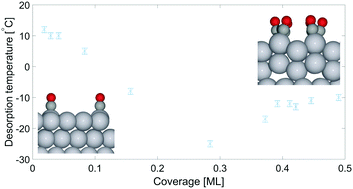Investigating the coverage dependent behaviour of CO on Gd/Pt(111)†
Abstract
Gd modified Pt(111) single crystals have been prepared in an ultra high vacuum (UHV). By vacuum deposition of ∼200 Å Gd on a sample heated to 800 °C, a Pt5Gd alloy terminated by a single atomic layer of Pt was formed. Subsequently the surfaces were characterized using low energy electron diffraction (LEED), showing that a highly ordered crystal structure had appeared. To study the molecular dynamics on this surface a detailed study of the CO adsorption on the surface was conducted using temperature programmed desorption (TPD) of CO. The TPD spectra show a desorption peak shifted down in temperature compared to those of pure Pt(111). The shape of the desorption peak and the desorption temperature were shown to be strongly dependent on the CO coverage of the surface. A systematic investigation of CO desorption temperature as a function of coverage was consequently performed. A simple simulation of the TPD spectra was carried out, based on adsorption energies from density functional theory (DFT). This simulation reproduces the shift and the narrowing of the desorption spectrum from the experiments and the DFT calculations suggest that the sharp TPD feature arises from cooperative adsorbate interactions, caused by subtle reconstructions occurring at coverages above 1/3 ML CO, whereas the overall temperature shift relative to pure Pt(111) comes from weaker CO binding due to the contraction of the Gd/Pt(111) surface.



 Please wait while we load your content...
Please wait while we load your content...